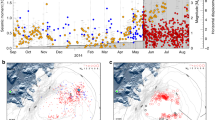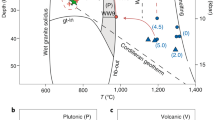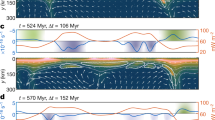Abstract
Direct constraints on the ascent, storage and eruption of mantle melts come primarily from exhumed, long-frozen intrusions. These structures, relics of a dynamic magma transport network, encode how Earth’s crust grows and differentiates over time. Furthermore, they connect mantle melting to an evolving distribution of surface volcanism. Disentangling magma transport processes from the plutonic record is consequently a seminal but unsolved problem. Here we use field data analyses, scaling theory and numerical simulations to show that the size distribution of intrusions preserved as plutonic complexes in the North American Cordillera suggests a transition in the mechanical response of crustal rocks to protracted episodes of magmatism. Intrusion sizes larger than about 100 m follow a power-law scaling expected if energy delivered from the mantle to open very thin dykes and sills is transferred to intrusions of increasing size. Merging, assimilation and mixing of small intrusions into larger ones occurs until irreversible deformation and solidification dissipate available energy. Mantle magma supply over tens to hundreds of thousands of years will trigger this regime, a type of reverse energy cascade, depending on the influx rate and efficiency of crustal heating by intrusions. Identifying regimes of magma transport provides a framework for inferring subsurface magmatic processes from surface patterns of volcanism, information preservation in the plutonic record, and related effects including climate.
This is a preview of subscription content, access via your institution
Access options
Access Nature and 54 other Nature Portfolio journals
Get Nature+, our best-value online-access subscription
$29.99 / 30 days
cancel any time
Subscribe to this journal
Receive 12 print issues and online access
$259.00 per year
only $21.58 per issue
Buy this article
- Purchase on Springer Link
- Instant access to full article PDF
Prices may be subject to local taxes which are calculated during checkout



Similar content being viewed by others
References
Crisp, J. A. Rates of magma emplacement and volcanic output. J. Volcanol. Geotherm. Res. 20, 177–211 (1984).
White, S. M., Crisp, J. A. & Spera, F. J. Long-term volumetric eruption rates and magma budgets. Geochem. Geophys. Geosyst. 7, Q03010 (2006).
Lee, C.-T. A., Thurner, S., Paterson, S. R. & Cao, W. The rise and fall of continental arcs: interplays between magmatism, uplift, weathering, and climate. Earth Planet. Sci. Lett. 425, 105–119 (2015).
Cashman, K. V., Sparks, R. S. J. & Blundy, J. D. Vertically extensive and unstable magmatic systems: a unified view of igneous processes. Science 355, aag3055 (2017).
Davidson, J., Tepley, F., Palacz, Z. & Meffan-Main, S. Magma recharge, contamination and residence times revealed by in situ laser ablation isotopic analysis of feldspar in volcanic rocks. Earth Planet. Sci. Lett. 184, 427–442 (2001).
de Silva, S. L. & Gosnold, W. D. Episodic construction of batholiths: insights from the spatiotemporal development of an ignimbrite flare-up. J. Volcanol. Geotherm. Res. 167, 320–335 (2007).
Aoki, Y., Segall, P., Kato, T., Cervelli, P. & Shimada, S. Imaging magma transport during the 1997 seismic swarm off the Izu Penninsula, Japan. Science 286, 927–930 (1999).
Petford, N. Rheology of granitic magma during ascent and emplacement. Annu. Rev. Earth Planet. Sci. 31, 399–427 (2003).
Wada, Y. On the relationship between dike width and magma viscosity. J. Geophys. Res. 99, 17743–17755 (1994).
Rubin, A. M. Getting granite dikes out of the source region. J. Geophys. Res. B4, 5911–5929 (1995).
Krumbholz, M. et al. Weibull-distributed dyke thickness reflects probabilistic character of host-rock strength. Nat. Commun. 5, 3272 (2014).
McCaffrey, K. & Petford, N. Are granitic plutons scale invariant? J. Geol. Soc. Lond. 154, 1–4 (1997).
Annen, C. & Sparks, R. S. J. Effects of repetitive emplacement of basaltic intrusions on thermal evolution and melt generation in the crust. Earth Planet. Sci. Lett. 203, 937–955 (2002).
Michaut, C. & Jaupart, C. Two models for the formation of magma reservoirs by small increments. Tectonophysics 500, 34–49 (2011).
Jellinek, A. M. & DePaolo, D. J. A model for the origin of large silicic magma chambers: precursors of caldera-forming eruptions. Bull. Volcanol. 65, 363–381 (2003).
Gerya, T. V. & Burg, J.-P. Intrusion of ultramafic bodies into the continental crust: numerical simulation. Phys. Earth Planet. Inter. 160, 124–142 (2007).
Karlstrom, L., Dufek, J. & Manga, M. Magma chamber stability in arc and continental crust. J. Volcanol. Geotherm. Res. 190, 249–270 (2010).
Hutton, D. H. W. & Reavy, R. J. Strike-slip tectonics and granite petrogenisis. Tectonics 11, 960–967 (1992).
McNulty, B. A., Tong, W. & Tobisch, O. T. Assembly of a dike-fed magma chamber: the Jackass Lakes pluton, central Sierra Nevada, California. Geol. Soc. Am. Bull. 108, 926–940 (1996).
Paterson, S., Memeti, V., Mundil, R. & Zak, J. Implications of repeated, multiscale, magmatic erosion and recycling in a mid-crustal pluton. Am. Mineral. 101, 2176–2198 (2016).
Wiebe, R. A. Basaltic injections into floored silicic magma chambers. EOS Trans. Am. Geophys. Union 74, abstr. V44C-06 (1993).
Vigneresse, J. L. & Bouchez, J. L. Successive granitic magma batches during pluton emplacement: the case of Cabeza de Araya (Spain). J. Petrol. 38, 1767–1776 (1997).
Paterson, S., Okaya, D., Memeti, V., Economos, R. & Miller, R. Magma addition and flux calculations of incrementally constructed magma chambers in continental margin arcs: combined field, geochronologic, and thermal modeling studies. Geosphere 7, 1439–1468 (2011).
Rubin, A. M. Dikes vs. diapirs in viscoelastic rock. Earth Planet. Sci. Lett. 117, 653–670 (1993).
Karlstrom, L., Dufek, J. & Manga, M. Organization of volcanic plumbing through magmatic lensing by magma chambers and volcanic edifices. J. Geophys. Res. 114, B006339 (2009).
Galland, O., Burchardt, S., Hallot, E., Mourgues, R. & Bulois, C. Dynamics of dikes versus cones sheets in volcanic systems. J. Geophys. Res. 119, 6178–6192 (2014).
Townsend, M. R., Pollard, D. D. & Smith, R. P. Mechanical models for dikes: a third school of thought. Tectonophysics 703, 98–118 (2017).
Miller, R. B. & Paterson, S. R. Construction of mid-crustal sheeted plutons: examples from the North Cascades, Washington. Geol. Soc. Am. Bull. 113, 1423–1442 (2001).
Cathles, L. M. An analysis of the cooling of intrusives by ground-water convection which includes boiling. Econom. Geol. 72, 804–826 (1977).
Rubie, D. C. Reaction-enhanced ductility: the role of solid-solid univariant reactions in deformation of the crust and mantle. Tectonophysics 96, 331–352 (1983).
Kirby, S. H. & Kronenberg, A. K. Rheology of the the lithosphere: selected topics. Rev. Geophys. 25, 1219–1244 (1987).
Menand, T., Annen, C. & de Saint Blanquat, M. Rates of magma transfer in the crust: insights into magma reservoir recharge and pluton growth. Geology 43, 199–202 (2015).
Petford, N. & Gallagher, K. Partial melting of mafic (amphibolitic) lower crust by periodic influx of basaltic magma. Earth Planet. Sci. Lett. 193, 483–499 (2001).
Kolmogorov, A. N. The local structure of turbulence in incompressible viscous fluid for very large Reynolds numbers. Proc. USSR Acad. Sci. 30, 9–13 (1941).
England, P. & McKenzie, D. A thin viscous sheet model for continental deformation. Geophys. J. Int. 70, 295–321 (1982).
Weinberg, R. F. Mesoscale pervasive felsic magma migration: alternatives to dyking. Lithos 46, 393–410 (1999).
Christopher, T. E. et al. Crustal-scale deagssing due to magma system destabilization and magma-gas decoupling at Soufreiére Hills Volcano, Montserrat. Geochem. Geophys. Geosyst. 16, 2797–2811 (2015).
Jerolmack, D. J. & Paola, C. Shredding of environmental signals by sediment transport. Geophys. Res. Lett. 37, L044638 (2010).
Kent, A. J. R., Darr, C., Koleszar, A. M., Salisbury, M. J. & Cooper, K. M. Preferential eruption of andesitic magmas through recharge filtering. Nat. Geosci. 3, 631–636 (2010).
Matzel, J. E. P. & Bowring, S. A. Time scales of pluton construction at differing crustal levels: examples from the Mount Stuart and Tenpeak intrusions, North Cascades, Washington. GSA Bull. 118, 1412–1430 (2006).
Ducea, M. N., Paterson, S. R. & Decelles, P. G. High-volume magmatic events in subduction systems. Elements 11, 99–104 (2015).
Bryan, S. E. & Ferrari, L. Large igneous provinces and silicic large igneous provinces: progress in our understanding over the last 25 years. Geol. Soc. Am. Bull. 125, 1053–1078 (2013).
Bak, P., Tang, C. & Wiesenfeld, K. Self-organized criticality - an explanation for 1/f noise. Phys. Rev. Lett. 59, 381–384 (1987).
Lenardic, A., Jellinek, A. M., Foley, B., O’Neill, C. & Moore, W. B. Climate-tectonic coupling: variations in the mean, variations about the mean, and variations in the mode. J. Geophys. Res. 121, 1831–1864 (2016).
Dessert, C. et al. Erosion of Deccan Traps determined by river geochemistry: impact on the global climate and the 87Sr/86Sr ratio of seawater. Earth Planet. Sci. Lett. 188, 459–474 (2001).
Jellinek, A. M. & Jackson, M. G. Connections between the bulk composition, geodynamics and habitability of Earth. Nat. Geosci. 8, 587–593 (2015).
Ray, R., Sheth, H. C. & Mallik, J. Structure and emplacement of the Nandurbar-Dhule mafic dyke swarm, Deccan Traps, and the tectonomagmatic evolution of flood basalts. Bull. Volcanol. 69, 537–551 (2007).
Muirhead, J. D., White, G. A. J. D. L. & Rowland, J. V. Cracking the lid: sill-fed dikes are the likely feeders of flood basalt eruptions. Earth Planet. Sci. Lett. 406, 187–197 (2014).
Wager, L. R. & Brown, G. M. Layered Igneous Rocks (Oliver and Boyd, 1967).
Irvine, T. N. Terminology for layered intrusions. J. Petrol. 23, 127–162 (1982).
Cawthorn, R. G. Layered Intrusions (Elsevier, 1996).
Zak, J. & Paterson, S. R. Characteristics of internal contacts in the Tuolumne Batholith, central Sierra Nevada, California (USA): implications for episodic emplacement and physical processes in a continental arc magma chamber. GSA Bull. 117, 1242–1255 (2005).
Paterson, S. R., Zak, J. & Janousek, V. Growth of complex magmatic zones during recycling of older magmatic phases: the Sawmill Canyon area in the Toulumne Batholith, Sierra Nevada, California. J. Volcanol. Geotherm. Res. 177, 457–484 (2008).
Miller, C. F. et al. Growth of plutons by incremental emplacement of sheets in crystal-rich host: evidence from Miocene intrusion of the Colorado River region, Nevada, USA. Tectonophysics 500, 65–77 (2011).
Hardee, H. C. Incipient magma chamber formation as a result of repetitive intrusions. Bull. Volcanol. 45, 41–49 (1982).
Lagarde, J. L., Brun, J. P. & Gapais, D. Formation of epizonal granitic plutons by in situ assemblage of laterally expanding magma. Adadémie des Sci. Comptes Rednus 310, 1109–1114 (1990).
Johnson, S. E., Paterson, S. R. & Tate, M. C. Structure and emplacement history of a multiple-center, cone-sheet-bearing ring complex: the Zarza Intrusive Complex, Baja California, Mexico. Geol. Soc. Am. Bull. 111, 607–619 (1999).
Lipman, P. W. Incremental assembly and prolonged consolidation of Cordilleran magma chambers: evidence from the Southern Rocky Mountain volcanic field. Geosphere 3, 42–70 (2007).
Michel, J., Baumgartner, L., Putliz, B., Schaltegger, U. & Ovtcharova, M. Incremental growth of the Patagonian Torres del Paine laccolith over 90 k.y. Geology 36, 459–462 (2008).
Cruden, A. R. & McCaffrey, K. J. W. Growth of plutons by floor subsidence: implications for rates of emplacement, intrusion spacing and melt-extraction mechanisms. Phys. Chem. Earth A 26, 303–315 (2001).
Miller, R. B., Patterson, S. R. & Matzel, J. P. Plutonism at different crustal levels: insights from the ∼5-40 km (paleodepth) North Cascades crustal section, Washington. Geol. Soc. Am. Spec. Pap. 456, 125–149 (2009).
Vernon, R. H. & Paterson, S. R. Mesoscopic structures resulting from crystal accumulation and melt movement in granites. Trans. R. Soc. Edinburgh 97, 369–381 (2006).
Dufek, J. & Bergantz, G. W. Lower crustal magma genesis and preservation: a stochastic framework for the evaluation of basalt-crust interaction. J. Petrol. 46, 2167–2195 (2005).
Schöpa, A. & Annen, C. The effects of magma flux variations on the formation and lifetime of large silicic magma chambers. J. Geophys. Res. 118, 1–17 (2013).
Carrigan, C. R. Biot number and thermos bottle effect: implications for magma-chamber convection. Geology 16, 771–774 (1988).
Segall, P. Earthquake and Volcano Deformation (Princeton, 2010).
Degruyter, W. & Huber, C. A model for eruption frequency of upper crustal silicic magma chambers. Earth Planet. Sci. Lett. 403, 117–130 (2014).
Annen, C. From plutons to magma chambers: thermal constraints on the accumulation of eruptible silicic magma in the upper crust. Earth Planet. Sci. Lett. 284, 409–416 (2009).
Bürgmann, R. & Dresen, G. Rheology of the lower crust and upper mantle: evidence from rock mechanics, geodesy, and field observations. Annu. Rev. Earth Planet. Sci. 36, 531–567 (2008).
Jellinek, A. M., Gordon, R. G. & Zatman, S. Experimental tests of simple models for the dynamics of diffuse oceanic plate boundaries. Geophys. J. Int. 164, 624–632 (2006).
Regenauer-Lieb, K. & Yuen, D. A. Modeling shear zone in geological and planetary sciences: solid- and fluid-thermal-mechanical approaches. Earth-Sci. Rev. 63, 295–349 (2003).
Acknowledgements
L.K. and S.R.P. acknowledge support from NSF. L. Vanderkluysen provided Deccan Traps dyke thickness data.
Author information
Authors and Affiliations
Contributions
L.K. and A.M.J. conceived the study, developed the model and wrote the paper. S.R.P. compiled plutonic intrusion size data and provided critical input related to field observations. L.K. carried out all calculations.
Corresponding author
Ethics declarations
Competing interests
The authors declare no competing financial interests.
Supplementary information
Supplementary Information
Supplementary Information (PDF 432 kb)
Supplementary Information
Supplementary Information (XLSX 59 kb)
Rights and permissions
About this article
Cite this article
Karlstrom, L., Paterson, S. & Jellinek, A. A reverse energy cascade for crustal magma transport. Nature Geosci 10, 604–608 (2017). https://doi.org/10.1038/ngeo2982
Received:
Accepted:
Published:
Issue Date:
DOI: https://doi.org/10.1038/ngeo2982
This article is cited by
-
Geochemical variability as an indicator for large magnitude eruptions in volcanic arcs
Scientific Reports (2022)
-
The life cycle of large igneous provinces
Nature Reviews Earth & Environment (2021)
-
Magma diversity reflects recharge regime and thermal structure of the crust
Scientific Reports (2020)
-
Determining the current size and state of subvolcanic magma reservoirs
Nature Communications (2020)
-
Optimal depth of subvolcanic magma chamber growth controlled by volatiles and crust rheology
Nature Geoscience (2019)



